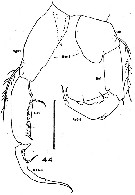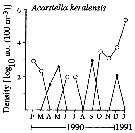|
|
 |
|
Calanoida ( Order ) |
|
|
|
Diaptomoidea ( Superfamily ) |
|
|
|
Acartiidae ( Family ) |
|
|
|
Acartiella ( Genus ) |
|
|
| |
Acartiella keralensis (Wellershaus, 1969) (F,M) | |
| | | | | | | Syn.: | Acartia (Acartiella) keralensis Wellershaus, 1969 (p.265, figs.F,M); Goswami & Goswami, 1974 (p.109, fig. caryotypes); Barthélémy, 1999 (p.860, figs.F) |  Issued from : S. Wellershaus in Veröff. Inst. Meeresforsch. Bremerh., 1969, 11 (2). [p.264, Fig.37-43]. Female (from Cochin Backwater, India): 37, urosome (ventral; anal operculum on dorsal side)39, A1 (A,A indicate the same place); 40, habitus (dorsal; black marks indicate blue-violet pigmentation); 41, P5. Nota: Ratio prosome : urosome = 1.37. Forehead without rostrum or filaments. Basipod 2 (= basis) of A2 with 2 setae; the distance between these setae and endopod is longer than in Acartiella tortaniformis; exopod fused with the basipod 2. Proportions of the urosomal segments 24, 16; anal-right Caudal rami 61 %. Male: 38, A1 (segments 14 to 25); 42, urosome (dorsal); 43, A2.
Scale : single line = 0.1 mm ; double line = 0.05 mm.
|
 Issued from : S. Wellershaus in Veröff. Inst. Meeresforsch. Bremerh., 1969, 11 (2). [p.266, Fig.44]. Male: 44, P5.
Scale : single line = 0.1 mm ; double line = 0.05 mm. Nota: Triangular projection on the coxa has half the length of the right basis. Exopodal segment 2-3 shows a characteristic shape, and the left basis has a rounded projection on the inner margin.
|
 issued from : R.-M. Bathélémy in J. Mar. Biol. Ass. U.K., 1999, 79. [p.858, Fig.1, A-B]. Scanning electon miccrograph. Female: A, genital double-somite (ventral ); B, detail of external genital area with insemination. Note the spermatophoral products (asterisk) covering the gonoporal plates under the opercular pad (large arrow) Scale bars: 0.030 mm (A), 0.020 mm (B). Symbols: arrowhead = cuticular folds limiting the genital area; large arrow = opercular pad; gp = gonoporal plate.
|
 Issued from : S. Wellershaus in Veröff. Inst. Meeresforsch. Bremerh., 1969, 11 (2). [p.265]. As Acartia (Acartiella) keralensis. Female: Proportions of the segments of A1.
|
 Issued from : S. Wellershaus in Veröff. Inst. Meeresforsch. Bremerh., 1969, 11 (2). [p.265]. As Acartia (Acartiella) keralensis. Female: Proportions of the abdominal segments for 5 animals.
|
 Issued from : S. Wellershaus in Veröff. Inst. Meeresforsch. Bremerh., 1969, 11 (2). [p.267]. As Acartia (Acartiella) keralensis. Male: Proportions of abdominal segment for 5 animals.
|
 Issued from : S. Wellershaus in Veröff. Inst. Meeresforsch. Bremerh., 1969, 11 (2). [p.265]. As Acartia (Acartiella) keralensis. Proportions of the female abdominal segments as an help for distinctions because A. keralensis closely resembles A. minor, A. tortaniformis and A. sewelli. Furthermore, A. keralensis is characterized by the shape of P5.
| | | | | Compl. Ref.: | | | Sewell, 1948 (p.324); Sarkar & al., 1986 (p.177, 178); Ramaiah & Nair, 1997 (tab.1); Mauchline, 1998 (tab.8); Achuthankutty & al., 1998 (p.1, Table 2, fig.5, seasonal abundance vs monsoon); Madhu & al., 2007 (p.54, Table 4, abundance vs monsoon); | | | | NZ: | 1 | | |
|
Distribution map of Acartiella keralensis by geographical zones
|
| | | | | |  issued from : C.T. Achuthankutty, N. Ramaiah & G. Padmavati in Pelagic biogeography ICoPB II. Proc. 2nd Intern. Conf. Final report of SCOR/IOC working group 93, 9-14 July 1995. Workshop Report No. 142, Unesco, 1998. [p.8, Fig.6]. issued from : C.T. Achuthankutty, N. Ramaiah & G. Padmavati in Pelagic biogeography ICoPB II. Proc. 2nd Intern. Conf. Final report of SCOR/IOC working group 93, 9-14 July 1995. Workshop Report No. 142, Unesco, 1998. [p.8, Fig.6].
Salinity ranges for Acartiella keralensis in coastal and estuarine waters of Goa (India).
Shaded area indicates the range of higher abundance. |
 issued from : C.T. Achuthankutty, N. Ramaiah & G. Padmavati in Pelagic biogeography ICoPB II. Proc. 2nd Intern. Conf. Final report of SCOR/IOC working group 93, 9-14 July 1995. Workshop Report No. 142, Unesco, 1998. [p.6, Fig.5]. issued from : C.T. Achuthankutty, N. Ramaiah & G. Padmavati in Pelagic biogeography ICoPB II. Proc. 2nd Intern. Conf. Final report of SCOR/IOC working group 93, 9-14 July 1995. Workshop Report No. 142, Unesco, 1998. [p.6, Fig.5].
Monthly occurrence of Acartiella keralensis in coastal (black circle) in front of Goa and and the Mandovi estuary (clear circle). |
 issued from : C.T. Achuthankutty, N. Ramaiah & G. Padmavati in Pelagic biogeography ICoPB II. Proc. 2nd Intern. Conf. Final report of SCOR/IOC working group 93, 9-14 July 1995. Workshop Report No. 142, Unesco, 1998. [p.3, Fig.2]. issued from : C.T. Achuthankutty, N. Ramaiah & G. Padmavati in Pelagic biogeography ICoPB II. Proc. 2nd Intern. Conf. Final report of SCOR/IOC working group 93, 9-14 July 1995. Workshop Report No. 142, Unesco, 1998. [p.3, Fig.2].
Hydrography of the coastal station in front of Goa and Mandovi estuarine station (W India).
Nota: The seasons are arbitrarily classified into the southwest monsoon (June-September), postmonsoon (October-January) and premonsoon (February-May). |
| | | | Loc: | | | India (Bombay, Goa, Cochin Backwater, Kerala) | | | | N: | 3 | | | | Lg.: | | | (172) F: 1,04; M: 1-0,932; {F: 1,04; M: 0,93-1,00} | | | | Rem.: | Estuaries. Brackish. | | | Last update : 15/12/2017 | |
|
|
 Any use of this site for a publication will be mentioned with the following reference : Any use of this site for a publication will be mentioned with the following reference :
Razouls C., Desreumaux N., Kouwenberg J. and de Bovée F., 2005-2025. - Biodiversity of Marine Planktonic Copepods (morphology, geographical distribution and biological data). Sorbonne University, CNRS. Available at http://copepodes.obs-banyuls.fr/en [Accessed January 02, 2026] © copyright 2005-2025 Sorbonne University, CNRS
|
|
 |
 |








